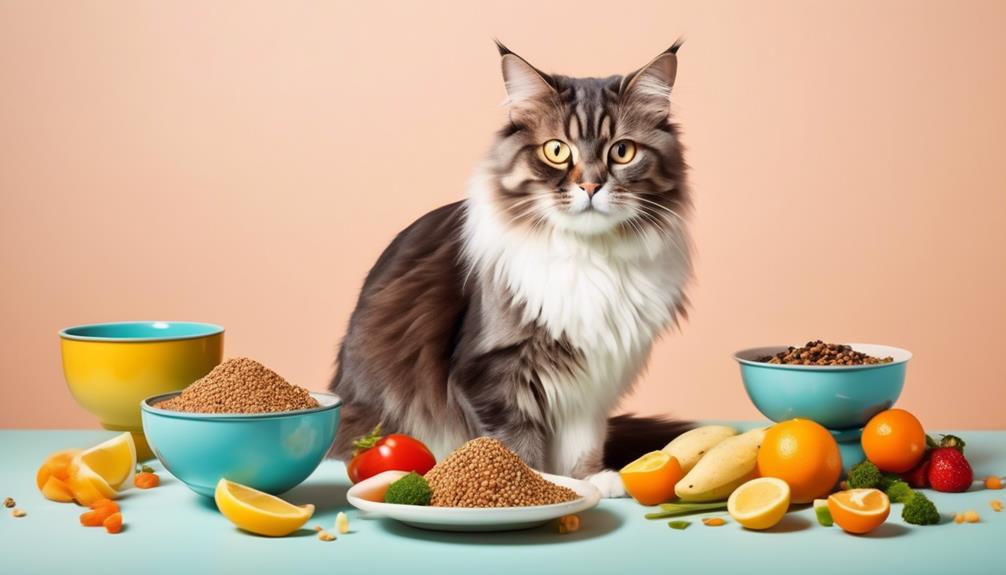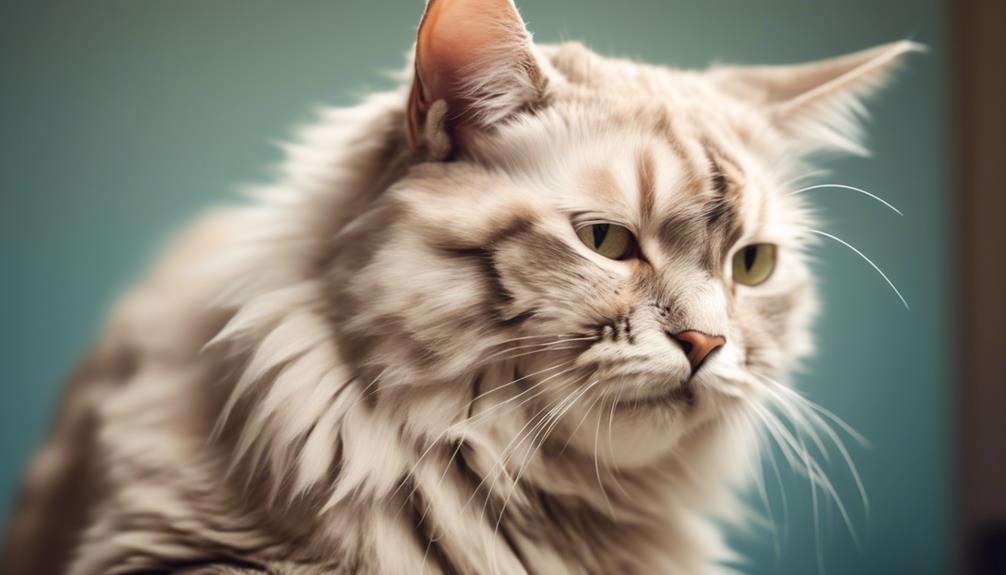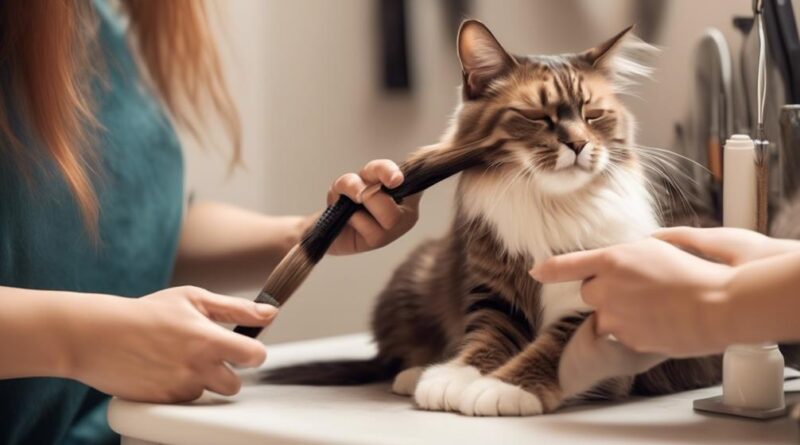11 Tips for Comprehending Cat Grooming Habits
So, you've finally realized that your feline friend's grooming habits are more complex than you ever imagined. You've witnessed the relentless licking, the occasional hairball, and the mysterious disappearance of your hair ties. You're not alone in wondering what goes on in that furry little head.
Understanding your cat's grooming habits can provide valuable insights into their overall health and well-being. In this discussion, we'll explore 11 practical tips to help you decode the world of cat grooming, from the significance of regular brushing to the impact of diet on their grooming routines.
These insights will not only deepen your bond with your cat but also empower you to better care for their grooming needs.
Understanding Cat's Licking Behavior
Understanding your cat's licking behavior is a key aspect of comprehending their grooming habits. Cats are meticulous groomers, and licking themselves is an essential part of their grooming routine. This behavior serves multiple purposes, including cleaning their fur, removing loose hair, and stimulating blood flow to their skin. By understanding your cat's licking behavior, you can gain insight into their overall health and well-being.
Cats have specific grooming techniques that they use during their licking sessions. They use their rough tongues to remove dirt, debris, and loose fur from their coats. The barbs on their tongues act like a natural comb, helping to detangle and smooth their fur. Additionally, cats use licking as a form of self-soothing and stress relief. When they feel anxious or agitated, grooming provides them with a calming sensation.
As a cat owner, it's important to observe your cat's licking behavior to ensure that it remains within normal limits. Excessive licking can be a sign of underlying health issues, such as skin allergies, parasites, or pain. Monitoring your cat's grooming habits can help you identify any changes in their behavior and seek veterinary attention if necessary.
Importance of Regular Brushing
Observing your cat's grooming habits, including their licking behavior, can lead you to understand the importance of regular brushing in maintaining their overall well-being. Regular brushing is crucial for your feline friend because it helps in shedding control and coat maintenance.
Here are four reasons why regular brushing is essential for your cat:
- Shedding control: Brushing your cat regularly helps to remove loose fur, preventing it from accumulating on your furniture and clothes. It also reduces the chances of hairballs, which can be uncomfortable for your cat and messy for you to clean up.
- Coat maintenance: Brushing your cat's coat helps to distribute natural oils, keeping their fur healthy and shiny. It also prevents matting and tangling, which can be painful for your cat and may require professional grooming to resolve.
- Bonding time: Regular brushing can be a pleasant bonding activity for you and your cat. It provides an opportunity for physical interaction and can help your cat feel more comfortable with being handled.
- Health check: While brushing, you can also check for any abnormalities such as lumps, bumps, or skin irritations. Early detection of such issues can lead to timely veterinary care, ensuring your cat's overall well-being.
Signs of Over-Grooming in Cats
Are you noticing your cat excessively licking or biting their fur? If so, they may be exhibiting signs of over-grooming.
Stress induced over grooming is a common cause of this behavior in cats. When cats feel stressed or anxious, they may resort to over grooming as a way to cope. This can lead to bald patches, skin irritation, and even open sores. Keep an eye on your cat's grooming habits, especially if you've noticed changes in their behavior or environment that could be causing stress.
In addition to stress, allergies can also lead to over grooming in cats. If your cat is allergic to certain foods, environmental factors, or parasites, they may excessively groom themselves in an attempt to alleviate the itching and discomfort. It's important to consult with your veterinarian to identify and address any underlying allergies that may be causing your cat to over groom.
As a cat owner, it's crucial to recognize the signs of over-grooming and take action to address the underlying causes. Providing a stimulating and stress-free environment for your cat, as well as addressing any potential allergies, can help prevent over-grooming behaviors. If you suspect that your cat is over grooming, seek advice from a veterinarian to determine the best course of action to support your feline friend's well-being.
Grooming as a Bonding Activity
Grooming your cat can be a wonderful bonding activity that not only helps maintain their coat but also strengthens your relationship with them. It's a time for you to connect with your feline friend, and it allows for mutual trust and affection to grow.
Here are some tips to make grooming a bonding activity with your cat:
- Start Slowly: If your cat isn't used to being groomed, introduce grooming gradually. Begin with short grooming sessions and gradually increase the time as your cat becomes more comfortable.
- Use Positive Reinforcement: Reward your cat with treats or verbal praise during and after grooming sessions. This positive reinforcement will help create a positive association with grooming.
- Respect Your Cat's Limits: Pay attention to your cat's body language. If they show signs of distress or discomfort, take a break and resume grooming later. It's important to respect your cat's boundaries to maintain trust.
- Try Different Grooming Techniques: Experiment with different grooming tools and techniques to find what your cat prefers. Some cats may enjoy being brushed, while others may prefer grooming gloves or combs. Finding the right technique can make grooming a more enjoyable experience for both you and your cat.
How Diet Affects Grooming Habits

A balanced diet plays a crucial role in shaping your cat's grooming habits, directly impacting the condition of their coat and skin. The impact of nutrition on your cat's grooming routine can't be overstated. Just like with humans, the saying 'you are what you eat' applies to cats as well. The quality of your cat's diet affects their overall health and, consequently, their grooming habits.
When your cat consumes a diet that's lacking in essential nutrients, their coat and skin may suffer. A poor diet can lead to dry, flaky skin and a dull, lackluster coat. On the other hand, a high-quality diet rich in essential fatty acids, vitamins, and minerals can result in a healthy, shiny coat and supple skin.
In addition to the physical effects, nutrition also influences your cat's grooming behavior. Cats who are uncomfortable due to skin irritations caused by a poor diet may excessively groom themselves in an attempt to alleviate the discomfort. This can lead to overgrooming, which may result in skin damage and hair loss.
Handling Mats and Tangles
Dealing with mats and tangles in your cat's coat can be a challenging aspect of grooming, requiring patience and the right tools for effective resolution. It's essential to take proactive steps to prevent tangles from forming in the first place. Regular brushing, especially for long-haired cats, helps to remove loose fur and prevents it from becoming tangled in the coat.
Additionally, incorporating these detangling techniques into your grooming routine can help keep your cat's coat smooth and mat-free:
- Use a metal comb: Invest in a high-quality metal comb with wide and narrow teeth. This will help you work through tough mats and tangles without causing discomfort to your cat.
- Apply detangling spray: A detangling spray can work wonders in loosening knots and making it easier to comb through your cat's fur. Look for a gentle, cat-friendly formula to avoid any skin irritation.
- Work in sections: When you encounter a mat or tangle, work through it in small sections. Start from the outer edges and slowly work your way towards the center to avoid pulling on your cat's skin.
- Be gentle and patient: Approach the task with a calm and gentle demeanor. Cats can be sensitive about their fur being tugged, so take your time and be patient during the detangling process.
Behavioral Changes in Elderly Cats

As your cat ages, you may notice changes in their behavior that warrant attention and understanding. One common issue in elderly cats is arthritis, which can lead to behavioral changes such as reduced activity, reluctance to jump, and irritability. If you notice these signs, it's important to consult your veterinarian for appropriate management strategies. Managing arthritis in elderly cats may involve providing comfortable bedding, gentle exercise, and possibly medication to alleviate discomfort and improve mobility.
Another important aspect of caring for elderly cats is dental care. Dental problems can be a source of significant discomfort and may lead to changes in behavior such as decreased appetite or increased irritability. Regular dental check-ups and professional cleanings can help maintain your cat's oral health and prevent issues that could affect their behavior and overall well-being.
In addition to physical conditions, elderly cats may also experience cognitive changes. They may become disoriented, forget litter box habits, or display signs of anxiety. Creating a calm and predictable environment, providing mental stimulation, and maintaining regular veterinary check-ups can help in managing these behavioral changes.
Understanding and addressing behavioral changes in elderly cats is crucial for ensuring their comfort and quality of life in their senior years. By being attentive to their needs and seeking appropriate veterinary care, you can help your aging feline companion navigate these changes with grace and comfort.
Seeking Professional Grooming Help
When grooming your cat becomes challenging or time-consuming, seeking professional grooming help can provide the expertise and care your feline companion needs. Here are some reasons why professional grooming assistance might be beneficial for your cat:
- Expertise: Professional groomers are trained to handle grooming tools and techniques that can be difficult for pet owners to use effectively.
- Specialized Tools: Groomers have access to specialized grooming tools that can make the process more efficient and comfortable for your cat.
- Grooming Frequency: If you find it challenging to maintain a regular grooming schedule for your cat, a professional groomer can ensure that your cat receives the appropriate grooming frequency.
- Health Monitoring: Professional groomers are often trained to spot potential health issues such as skin conditions, ear infections, or dental problems during the grooming process, allowing for early intervention.
Seeking professional grooming help can also be particularly beneficial for cats with long or thick coats, elderly cats who may have difficulty grooming themselves, or cats with behavioral issues that make grooming at home challenging.
Remember that providing your cat with the best grooming care can contribute to their overall health and well-being, so don't hesitate to seek professional help when needed.
Frequently Asked Questions
Can Cats Groom Each Other as a Bonding Activity?
Yes, cats can groom each other as a bonding activity. This behavior, known as mutual grooming, helps strengthen social bonds among cats. By grooming each other, they're showing trust and affection.
This bonding behavior is a way for cats to maintain social harmony within their group. It's a natural and positive interaction that helps cats feel more secure and connected to each other.
What Are Some Common Grooming Habits in Different Cat Breeds?
Different cat breeds exhibit unique shedding patterns and coat maintenance needs. Using the right grooming tools is crucial for keeping their fur in top condition. Regular grooming helps minimize shedding and promotes a healthy coat.
Short-haired breeds usually require less frequent grooming compared to long-haired ones. Understanding the grooming frequency and needs of your specific cat breed will ensure their coat stays healthy and beautiful.
How Can I Help My Cat With Grooming if They Have Mobility Issues?
If your cat has mobility issues, you can assist their grooming by using gentle handling and providing grooming assistance. Consider using mobility aids to help them reach certain areas.
You can also provide assisted grooming by using specialized tools that are easier for your cat to handle. Additionally, regular grooming sessions can help keep your cat clean and comfortable, so make sure to provide the necessary support for their grooming needs.
Are There Any Specific Grooming Techniques for Long-Haired Cats Versus Short-Haired Cats?
When grooming long-haired cats, brush regularly to prevent mats and tangles. Grooming techniques vary based on hair length. For short-haired cats, use a soft brush to remove loose fur and reduce shedding. Pay attention to common grooming habits and provide mobility assistance if needed. It's also a great bonding activity for you and your cat. Stress can affect grooming habits, so create a calm environment for grooming.
Can Stress or Anxiety Affect a Cat's Grooming Habits?
Yes, stress or anxiety can affect a cat's grooming habits. Cats may overgroom or undergroom themselves when stressed, anxious, or in discomfort. Medical conditions like allergies or skin irritations can also cause changes in grooming behavior. It's important to monitor your cat's grooming habits and consult a veterinarian if you notice any sudden changes.
Behavioral issues can also impact grooming, so providing a calm and comfortable environment is essential for maintaining healthy grooming habits.
Conclusion
Now that you have a better understanding of your cat's grooming habits, you can ensure they stay healthy and happy.
Regular brushing, monitoring for signs of over-grooming, and bonding through grooming sessions are all important aspects to consider.
Pay attention to your cat's behavior and diet, and don't hesitate to seek professional grooming help if needed.
By taking these tips into account, you can keep your feline friend looking and feeling their best.
